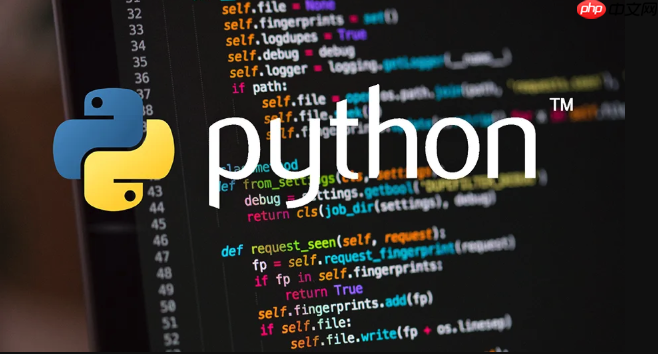答案是使用strip()方法可去除字符串两端的空白字符。Python中strip()用于移除字符串首尾的空格、制表符、换行符等,默认处理所有ASCII空白字符,且返回新字符串而不改变原字符串;lstrip()和rstrip()分别只移除左侧或右侧空白,三者均可传入字符集参数以移除指定字符,但需注意参数为字符集而非子字符串,且这些方法不处理字符串内部空白。

在Python中,要去除字符串两端的空格,最直接也最常用的方法就是使用字符串对象的
strip()
当我们需要对字符串进行修剪时,Python的
strip()
\t
\n
\r
strip()
比如,你可能从某个文件读取了一行数据,或者用户在表单里输入了一些内容,经常会发现前后带着不必要的空白:
dirty_string = " Hello, Python! \n\t"
cleaned_string = dirty_string.strip()
print(f"原始字符串: '{dirty_string}'")
print(f"清理后字符串: '{cleaned_string}'")
# 输出: 清理后字符串: 'Hello, Python!'如果你只关心左侧或右侧的空白,Python也提供了
lstrip()
rstrip()
lstrip()
left_padded = " Python is fun!"
print(f"原始字符串: '{left_padded}'")
print(f"lstrip() 后: '{left_padded.lstrip()}'")
# 输出: lstrip() 后: 'Python is fun!'而
rstrip()
立即学习“Python免费学习笔记(深入)”;
right_padded = "Python is powerful! \n"
print(f"原始字符串: '{right_padded}'")
print(f"rstrip() 后: '{right_padded.rstrip()}'")
# 输出: rstrip() 后: 'Python is powerful!'这些方法不仅可以处理默认的空白字符,你还可以给它们传入一个字符串参数,指定要移除的字符集。
strip()
很多人刚接触
strip()
string.strip()
\t
\n
\r
\f
\v
这意味着,无论你的字符串两端是几个空格,还是混杂着换行和制表符,
strip()
更进一步,
strip()
lstrip()
rstrip()
比如,你想去除字符串两端的特定符号,如逗号、点号或感叹号:
data_entry = "!!!Hello World!!!..."
cleaned_data = data_entry.strip('!.') # 注意这里是字符集 '!. ',不是子字符串
print(f"去除 '!' 和 '.' 后: '{cleaned_data}'")
# 输出: 去除 '!' 和 '.' 后: 'Hello World'如果你的字符串是
",,,Python,,,"
strip(',')'Python'
strip(',Py'),
P
,
P
y
tricky_string = "PythonythonP"
# 移除字符集 'Py' 中的任意字符
print(tricky_string.strip('Py')) # 结果是 'thon'
# 因为开头有 'P',移除;接着是 'y',移除;再接着是 't',不在字符集,停止左侧移除。
# 结尾有 'P',移除。所以,理解
strip()
strip()
lstrip()
rstrip()
在日常编码中,这三个方法的使用场景其实非常明确,选择它们取决于你对字符串哪一端的数据感兴趣。
strip()
name = input("请输入你的名字: ").strip()line.strip()
我个人在处理用户提交的搜索关键词时,
strip()
" python "
"python"
lstrip()
"prefix_file1.txt"
"file1.txt"
lstrip('prefix_')removeprefix()
replace()
lstrip()
"/api/v1/users"
"api/v1/users"
path.lstrip('/')int()
"007".lstrip('0')"7"
rstrip()
rstrip()
file.readline()
\n
line.rstrip('\n')"document.pdf"
"document"
filename.rstrip('.pdf')os.path.splitext()
"item1,item2,"
my_string.rstrip(',')总之,
strip()
lstrip()
rstrip()
strip()
尽管
strip()
字符串是不可变的,strip()
my_string.strip()
my_string
strip()
s = " hello "
s.strip() # 这一行没有任何效果,因为结果没有被捕获
print(f"s 仍然是: '{s}'") # 输出: s 仍然是: ' hello '
s = s.strip() # 这样才是正确的用法
print(f"s 现在是: '{s}'") # 输出: s 现在是: 'hello'记住这一点,因为这几乎是所有字符串方法共有的特性。
strip()
my_string.strip('abc')"abc"
'a'
'b'
'c'
s1 = "abccbaHelloabccba"
print(s1.strip('abc')) # 输出: 'Hello'
# 因为开头是 'a', 'b', 'c',都在字符集中,所以移除。
# 结尾是 'a', 'b', 'c',也都在字符集中,所以移除。
s2 = "PythonP"
print(s2.strip('P')) # 输出: 'ython'
# 开头的 'P' 移除,结尾的 'P' 移除。
s3 = "PythonythonP"
print(s3.strip('Py')) # 输出: 'thon'
# 开头的 'P', 'y' 移除,结尾的 'P' 移除。如果你真的需要移除特定的子字符串前缀或后缀,应该使用
str.removeprefix()
str.removesuffix()
str.replace()
strip()
strip()
strip()
sentence = " Hello world! \n"
cleaned_sentence = sentence.strip()
print(f"strip() 后: '{cleaned_sentence}'")
# 输出: strip() 后: 'Hello world!'
# 注意 ' world!' 中间的空格没有被移除。如果你的目标是移除字符串中所有多余的空白(包括内部的),你可能需要更复杂的逻辑,比如使用
str.split()
str.join()
normalized_sentence = " ".join(sentence.split())
print(f"规范化后: '{normalized_sentence}'")
# 输出: 规范化后: 'Hello world!'sentence.split()
" ".join(...)
理解这些细节,能让你更高效、更准确地使用
strip()
以上就是python中如何去除字符串两端的空格_Python字符串strip()方法使用技巧的详细内容,更多请关注php中文网其它相关文章!

python怎么学习?python怎么入门?python在哪学?python怎么学才快?不用担心,这里为大家提供了python速学教程(入门到精通),有需要的小伙伴保存下载就能学习啦!

Copyright 2014-2025 https://www.php.cn/ All Rights Reserved | php.cn | 湘ICP备2023035733号